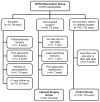Reduction in intraocular pressure after cataract extraction: the Ocular Hypertension Treatment Study
- PMID: 22608478
- PMCID: PMC3426647
- DOI: 10.1016/j.ophtha.2012.02.050
Reduction in intraocular pressure after cataract extraction: the Ocular Hypertension Treatment Study
Abstract
Purpose: To determine the change in intraocular pressure (IOP) after cataract extraction in the observation group of the Ocular Hypertension Treatment Study.
Design: Comparative case series.
Participants: Forty-two participants (63 eyes) who underwent cataract surgery in at least 1 eye during the study and a control group of 743 participants (743 eyes) who did not undergo cataract surgery.
Methods: We defined the "split date" as the study visit date at which cataract surgery was reported in the cataract surgery group and a corresponding date in the control group. Preoperative IOP was defined as the mean IOP of up to 3 visits before the split date. Postoperative IOP was the mean IOP of up to 3 visits including the split date (0, 6, and 12 months' with "0 months" equaling the split date). In both groups, we censored data after initiation of ocular hypotensive medication or glaucoma surgery of any kind.
Main outcome measures: Difference in preoperative and postoperative IOP.
Results: In the cataract group, postoperative IOP was significantly lower than the preoperative IOP (19.8 ± 3.2 mmHg vs. 23.9 ± 3.2 mmHg; P<0.001). The postoperative IOP remained lower than the preoperative IOP for at least 36 months. The average decrease in postoperative IOP from preoperative IOP was 16.5%, and 39.7% of eyes had postoperative IOP ≥ 20% below preoperative IOP. A greater reduction in postoperative IOP occurred in the eyes with the highest preoperative IOP. In the control group, the corresponding mean IOPs were 23.8 ± 3.6 before the split date and 23.4 ± 3.9 after the split date.
Conclusions: Cataract surgery decreases IOP in patients with ocular hypertension over a long period of time.
Copyright © 2012 American Academy of Ophthalmology. Published by Elsevier Inc. All rights reserved.
Figures


Comment in
-
Cataract extraction and the iris configuration.Ophthalmology. 2013 Jun;120(6):e29-30. doi: 10.1016/j.ophtha.2013.03.022. Ophthalmology. 2013. PMID: 23732062 No abstract available.
References
-
- Jahn CE. Reduced intraocular pressure after phacoemulsification and posterior chamber intraocular lens implantation. J Cataract Refract Surg. 1997;23:1260–4. - PubMed
-
- Mathalone N, Hyams M, Neiman S, et al. Long-term intraocular pressure control after clear corneal phacoemulsification in glaucoma patients. J Cataract Refract Surg. 2005;31:479–83. - PubMed
-
- Poley BJ, Lindstrom RL, Samuelson TW. Long-term effects of phacoemulsification with intraocular lens implantation in normotensive and ocular hypertensive eyes. J Cataract Refract Surg. 2008;34:735–42. - PubMed
-
- Poley BJ, Lindstrom RL, Samuelson TW, Schulze R., Jr Intraocular pressure reduction after phacoemulsification with intraocular lens implantation in glaucomatous and nonglaucomatous eyes: evaluation of a causal relationship between the natural lens and open-angle glaucoma. J Cataract Refract Surg. 2009;35:1946–55. - PubMed
-
- Shingleton BJ, Gamell LS, O’Donoghue MW, et al. Long-term changes in intraocular pressure after clear corneal phacoemulsification: normal patients versus glaucoma suspect and glaucoma patients. J Cataract Refract Surg. 1999;25:885–90. - PubMed
Publication types
MeSH terms
Substances
Grants and funding
LinkOut - more resources
Full Text Sources
Other Literature Sources
Medical

